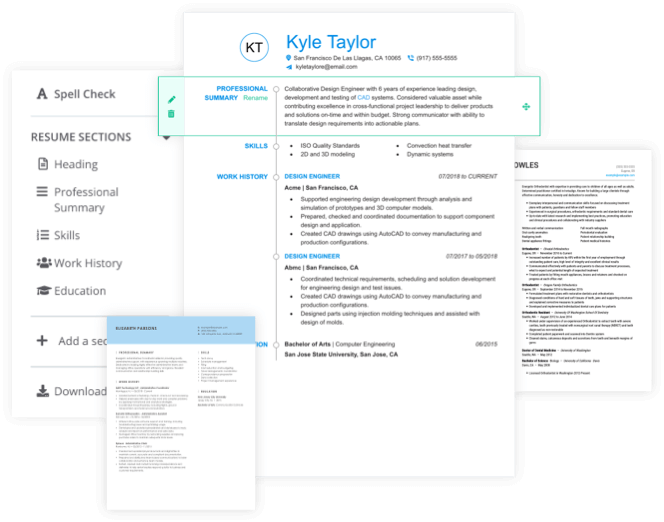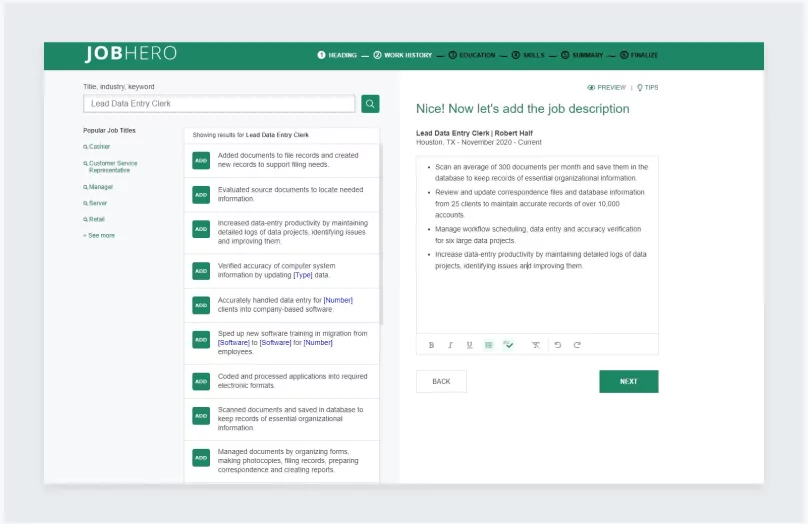- Featured in:

Tailors use their knowledge of garment construction and style to fit, alter, and create garments to client specifications. They read patterns, use measuring tools, and work with different fabrics and embellishments in the course of their work. Experienced tailors know how to hand-sew and machine-sew garments for both male and female customers.
Most tailors work full time for clothing stores, dry cleaners, apparel manufacturers, and maintenance services. However, some own and operate their own tailoring service. Although this occupation requires a great deal of skill, many tailors have little to no postsecondary education.
Our team of certified resume writers have created a library of resume examples to show you how to craft a strong resume. Study them to learn to write your own.
One extra step to impress a manager: A growing number of hiring professionals read cover letters to determine whether they’ll interview a candidate or not. Use our cover letter templates to craft a complete application that lands you the interview.
Tailor Duties and Responsibilities
While a tailor's day-to-day duties and responsibilities are determined by where they work, there are many core tasks associated with the role. Based on our analysis of job listings, these include:
Fit Customers
Tailors use measuring tools to measure bodies and fabrics to fit clothes to individual customers. They record measurements and perform measurement operations (add, subtract, multiply, and divide) to ensure proper fit of garments.
Mark Garments
Tailors use special chalk markers, also known as French chalk, to trace patterns on fabric and mark garments for future cutting, sewing, and other forms of alteration.
Perform Alterations
Alterations are sometimes required to custom fit a garment, such as a dress or suit jacket, to an individual. Tailors remove and add stitches to take in and let out seams, take up and let down hems, and separate and join garment parts.
Press Clothing
Tailors use irons, ironing boards, and other pressing tools, such as a tailors ham, to press fabrics prior to sewing. They also use a range of techniques to press collars, pleats, and other garment pieces for clients.
Design Garments
Some tailors use their knowledge of garment construction and style to make garments. They create custom patterns from dimensions, diagrams, and sketches, and then trim fabric to fit the patterns.
Tailor Skills and Qualifications
Measurement skills – tailors work with a variety of measuring tools, including tape, rulers, and curves; measurement accuracy and precision is required to ensure garments are not destroyed during the alteration process
Sewing ability – in addition to sewing garments by hand, tailors also use sewing machines to make garments and perform alterations. They work with a variety of embellishments, such as beads and buttons, and a wide range of fabrics, including knit and leather
Hand-eye coordination – tailors work with needles, thread, and small items like buttons; this requires good vision and manual dexterity
Creativity – making custom-fit garments that are both functional and stylish requires creativity, strong color perception, and an eye for fashion
Communication skills – tailors need excellent verbal communication skills to effectively and sensitively advise clients on the fit and style of garments
Tools of the Trade
- Measuring tape
- Garment shears
- Chalk markers
- Sewing machines
- Hand-sewing needles
- Thimbles
Tailor Education and Training
There are no minimum education requirements to become a tailor. They typically acquire their skills through practice. However, some individuals complete training programs or apprenticeships to learn how to work with luxury garments or acquire advanced skills, such as couture sewing.
Tailors who specialize in making customer garments sometimes complete a bachelor's degree in fashion design. While enrolled in the program, they learn about different types of textiles, fabrics, and computer-aided design technology. Licensure and certification is not required for tailors, but some choose to seek voluntary certification through organizations like the Custom Tailors and Designers Association (CTDA). Certification options include the Master Tailor/Designer, the Master Custom Designer, and the Master Custom Clothier designations.
Tailor Salary Outlook
According to the Bureau of Labor Statistics (BLS), tailors earn a median annual wage of $29,000. The highest-paid workers (in the top 10 percent) earn just over $50,000, while the lowest-paid workers (in the bottom 10 percent) earn less than $30,000. Some tailors also receive paid vacation time, sick days, or other benefits in addition to regular compensation.
According to the BLS, there are over 20,000 tailors employed in the United States. The BLS is projecting 3 percent growth in this occupation through 2026. Candidates with several years of tailoring experience have the best prospects.

Helpful Resources
Want to learn more about working as a tailor? Here is a list of industry resources to help you master key skills and learn more about this career path:
Custom Tailors and Designers Association
founded in 1880, CDTA is the oldest trade organization in the United States. It connects members through summits and other events, and provides education and certification opportunities for professional tailors, custom clothiers, and clothing designers
Make It, Own It, Love It: The Essential Guide to Sewing, Altering and Customizing
this guide to sewing was written by Matt Chapple, the winner of the BBC’s Great British Sewing Bee 2015. It provides simple instructions for using common tools to repair clothing, perform alterations, and make garments from scratch
The Sewing Machine Accessory Bible: Get the Most Out of Your Machine—From Using Basic Feet to Mastering Specialty Feet
written by Wendy Gardiner, editor of Sewing World, and Lorna Knight, author of several well-known sewing guides, The Sewing Machine Accessory Bible explains how to use sewing machine accessories to work with a wide range of fabrics. The book also contains advice to help readers choose the best sewing machines, embellishers, and sergers




